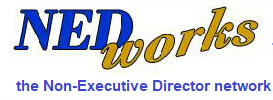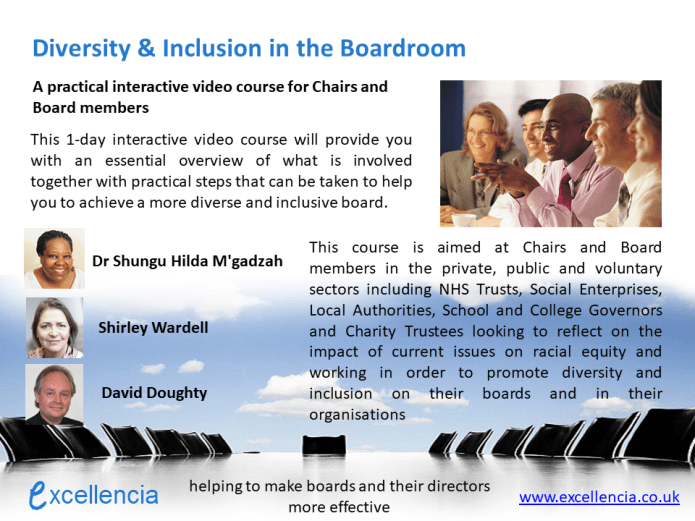
The recently updated Charity Governance Code includes clearer recommended practice in the renamed Equality, Diversity and Inclusion (EDI) Principle and sets out four stages of practice for charities in their EDI journey.
Boards should:
- Think about why equality, diversity and inclusion are important for the charity and assess the current level of understanding.
- Set out plans and targets tailored to the charity and its starting point.
- Monitor and measure how well the charity is doing.
- Be transparent and publish the charity’s progress.
So, how can charity trustees and in particular their Chairs tackle the four stages as a priority for 2021?
As a Chair of a registered charity and having worked with the boards of many charities on matters of Corporate Governance, I would like to suggest the following practical approaches that can be taken to help trustees on their journey to satisfy the four stages towards EDI compliance:
1. Think about why equality, diversity & inclusion are important for the charity and assess the current level of understanding.
EDI should not be seen as a box-ticking exercise or an attempt to address historical racial injustices – from the point of view of a charity trustee, it should be focused on asking the questions:
- how can we ensure that we are recruiting the best trustees, staff and volunteers?
- how can we best understand and meet the needs of the communities our trustee has been set up to serve?
- how can the board ‘set the tone from the top’ to ensure that the charity treats all its stakeholders with respect, equally and fairly in order that it can do the greatest amount of good in achieving its charitable objects?
In order to measure progress along the EDI journey, it is important to understand where the charity is now in terms of its current level of understanding of the issues involved and the barriers that may prevent equality, diversity and inclusion in the organisation.
This will involve discussion amongst the trustees and between the board and senior management and with staff and volunteers and may require training and facilitation, either internal or external, in order to produce a clear picture of where the charity is now in terms of EDI.
It is important at this stage to formulate a collective idea of ‘what good looks like’ and to manage the expectations of your key stakeholders.
Wherever you are starting your EDI journey it will involve change – increasing diversity means increasing difference and the board must recognise that if it is bringing potentially different people onto the board then it may well need to behave differently itself.
This requires a degree of self-awareness and possibly changes in terms of style and presentation to ensure that the board is truly inclusive. The whole point is to recruit trustees who will bring new ways of supporting and challenging the executives and fellow board members – this should be anticipated and welcomed by all the current trustees.
2. Set out plans and targets tailored to the charity and its starting point.
A good place to start is the charity’s Articles of Association, or other constitutional document. It is good practice to review them regularly, say every 5 years, anyway but particularly when there is a change in the law or Corporate Governance Code.
By law, trustees must be appointed for a fixed period of time and your Articles will say how often trustees should be presented for re-election at the annual general meeting – typically one third of the board will resign each year and trustees will either seek re-election or new trustees will need to be recruited.
It is good practice to appoint trustees for an initial term of 3 years and they may then serve a total of 6 or 9 years on the board.
If you are thinking of refreshing the board to make the membership more diverse, then it is a useful starting point to know when your current trustees are due to retire – though stepping down from the board is not necessarily the end of a trustees’ involvement with the charity, there is still an opportunity to play an important role as an Advisory Board member, or, with particular importance to EDI, as a mentor to new trustees.
The next thing to look at is the skills of the current trustees to see if there are any gaps. Typically, charity trustees were recruited with a legal or accountancy background but these days, charities also need digital marketing, information governance and cyber-security expertise in order to be able to effectively challenge the executives.
Finally, it is a good idea to examine your recruitment adverts, your website content, particularly on the charity’s governance and where you are advertising for new trustees.
Often the language used in trustee vacancy adverts tends to be off-putting for various sectors of the community from which you are looking to recruit – think about any unconscious bias which may be present which may deter applications from anyone who is not comfortable with the language you are using in the text.
It is a good idea to try out the content with members of the communities that you are targeting and seek their opinion on the best ways to reach the intended audience.
One of the most common hurdles which must be overcome is the apparent lack of suitable candidates for new trustee appointments.
The 2017 research report, Taken on Trust, published by the Charity Commission found that
92% of trustees were white, 51% were retired, 75% were richer than average, and 60% had a professional qualification
– so adverts asking for previous trustee experience are unlikely to receive applications other than from the demographic highlighted in the report.
In order to search a wider pool of potential trustee talent, boards need to consider appointing associate trustees who can then ‘learn on the job’ – with the help and support of mentors who may will be the trustees that the new recruits are replacing.
Programs such as those run by Board Apprentice and the NHS NExT director scheme are a great way to expand the talent pool of diverse candidates for board positions.
By the end of this stage you should have a timeline and a clear set of actions. When it comes to setting targets, these should be set with regard to improvements in the board’s effectiveness and the charity’s performance and not numeric or percentage targets based on protected characteristics.
3. Monitor and measure how well the charity is doing.
Organisational change is always difficult, particularly for a charity board of volunteer trustees – there will be some trustees who wholeheartedly embrace change, some who are indifferent and some who actively oppose change.
Difficult conversations will have to be had, especially when it comes to boardroom behaviours and there may have to be an early parting of the ways for trustees who are unwilling or unable to come to terms with the challenge.
Having engaged and involved stakeholders at the start of the journey it is important to keep them informed of progress at regular intervals. A board EDI program may also be run in parallel with one for the rest of the organisation and learning opportunities should be encouraged between the two.
Key to the success of an EDI program is building and maintain relationships with the communities from which you are looking to attract new trustees. There are a great many organisations, often charities themselves, who will welcome the opportunity to help you to make your board and charity more inclusive – they may also have a lack of diversity on their own boards so their may be an opportunity for reciprocal support.
The main message is: ‘don’t be afraid to ask’.
4. Be transparent and publish the charity’s progress.
The opposite of a diverse and inclusive board is a secretive, exclusive mono-culture, of which, unfortunately, many examples can still be found. Transparency is key to ensuring that the EDI journey is seen as a genuine desire to improve the effectiveness of the board and the performance of the charity by engaging with and recruiting trustees from as wide a talent pool as possible.
Making good progress and being able to talk about the journey openly can be a source of competitive difference when it comes to winning scarce grant funding.
It is a virtuous cycle – getting the best people on board and as staff and volunteers, regardless of gender, ethnicity, disability or sexual orientation makes for a better charity which then enables it to meet the needs of the community it serves more effectively, which leads to enhanced reputation and funding.
Top finds
- Casinos Not On Gamstop
- Non Gamstop Casinos
- Migliori Siti Casino Online
- Betting Sites UK
- Casinos Not On Gamstop
- Gambling Sites Not On Gamstop
- Casino Online Non Aams
- UK Online Casinos Not On Gamstop
- Sites Not On Gamstop
- Non Gamstop Casino Sites UK
- Online Casino Real Money
- Sites Not On Gamstop
- Best Non Gamstop Casinos 2025
- UK Gambling Sites Not On Gamstop
- UK Online Casinos Not On Gamstop
- UK Casinos Not On Gamstop
- I Migliori Casino Non Aams
- Best New Slot Sites UK
- UK Slot Sites
- Meilleur Casino En Ligne
- UK Casino Not On Gamstop
- Casino Not On Gamstop
- Best Non Gamstop Casinos
- Lista Casino Online Non Aams
- Casino Non Aams Italia
- Paris Sportif Tennis
- Casino En Ligne France
- Crypto Betting Sites
- Meilleur Site De Pari En Ligne
- найкраще казино
 A really useful day for anyone with serious intentions of becoming a NED. The event was well structured with a good balance between the theory of corporate governance and NED responsibilities as well as allowing plenty of time for sharing experiences through group interaction
A really useful day for anyone with serious intentions of becoming a NED. The event was well structured with a good balance between the theory of corporate governance and NED responsibilities as well as allowing plenty of time for sharing experiences through group interaction Helpful and fulsome in opening up the channel of Non-Executive Director as a career path. I know considerably more about what is required and expected now and, of real practical benefit, how to go about seeking and finding a rewarding role as an NED. Highly recommended.
Helpful and fulsome in opening up the channel of Non-Executive Director as a career path. I know considerably more about what is required and expected now and, of real practical benefit, how to go about seeking and finding a rewarding role as an NED. Highly recommended. I really enjoyed the last meeting. The seminar in particular was the best
I really enjoyed the last meeting. The seminar in particular was the best  Knowledgeable presenter Good solid coverage of core financial concepts - P&L, balance sheet, ratios
Knowledgeable presenter Good solid coverage of core financial concepts - P&L, balance sheet, ratios is an essential introduction for those who seriously wish to pursue Non Executive Director Roles. The course, led by David Doughty an experienced and knowledgeable NED, is focused on the key information required to achieve your first position. It includes a discussion of the Non Executive Director Role, duties and liabilities, the relevant skill set and valid approaches to securing a NED position. The day includes case study work as well as interactive discussions of the course material. I thoroughly recommend this course which is good value for money.
is an essential introduction for those who seriously wish to pursue Non Executive Director Roles. The course, led by David Doughty an experienced and knowledgeable NED, is focused on the key information required to achieve your first position. It includes a discussion of the Non Executive Director Role, duties and liabilities, the relevant skill set and valid approaches to securing a NED position. The day includes case study work as well as interactive discussions of the course material. I thoroughly recommend this course which is good value for money. The course was a really thorough grounding in what it means to be a non-exec director and how you can apply your knowledge and skills to the role to good effect. The combination of useful information about corporate governance and directors' liabilities, a very experienced and insightful course lead in the form of David Doughty, and practical exercises about how to address particular situations that NEDs can expect to face made for a very interesting session, but also one which was directly applicable to my new role.
The course was a really thorough grounding in what it means to be a non-exec director and how you can apply your knowledge and skills to the role to good effect. The combination of useful information about corporate governance and directors' liabilities, a very experienced and insightful course lead in the form of David Doughty, and practical exercises about how to address particular situations that NEDs can expect to face made for a very interesting session, but also one which was directly applicable to my new role. I would thoroughly recommend this course. It gave me an excellent overview of the role of a NED and a clear steer on how best to look for and be successful in becoming a NED. All my pre course questions were answered. The examples the tutor gave were interesting and stimulated good debate. The small size of the group allowed questions and good dialogue. Look no further for a course on this subject
I would thoroughly recommend this course. It gave me an excellent overview of the role of a NED and a clear steer on how best to look for and be successful in becoming a NED. All my pre course questions were answered. The examples the tutor gave were interesting and stimulated good debate. The small size of the group allowed questions and good dialogue. Look no further for a course on this subject Well worth the time! Duncan has packed a lot of information into the course, which reminded me of all the things I should be thinking about, and doing something about in my own business, and also sent me away with some action items. Highly recommended!
Well worth the time! Duncan has packed a lot of information into the course, which reminded me of all the things I should be thinking about, and doing something about in my own business, and also sent me away with some action items. Highly recommended! Unlike many courses I have attended in the past,
Unlike many courses I have attended in the past,  The course was well constructed and delivered by David who has extensive knowledge of a range of boards, their structure and governance. It was particularly helpful to me as I am new to applying for NED roles and the guidance made me totally rethink what is required from the application process – i.e. this is not an operational role! The delegate group was of a suitable size to allow for interaction and sharing of ideas and experience
The course was well constructed and delivered by David who has extensive knowledge of a range of boards, their structure and governance. It was particularly helpful to me as I am new to applying for NED roles and the guidance made me totally rethink what is required from the application process – i.e. this is not an operational role! The delegate group was of a suitable size to allow for interaction and sharing of ideas and experience Having attended one of David's
Having attended one of David's  This course was excellent and greatly exceeded my expectations. The course format is interactive, with small-group teaching in a seminar/workshop format, led by an experienced Chartered Director who generously shared his personal experience
This course was excellent and greatly exceeded my expectations. The course format is interactive, with small-group teaching in a seminar/workshop format, led by an experienced Chartered Director who generously shared his personal experience David is a solid expert. The overview of the role of a NED was very well presented. Highly recommended.
David is a solid expert. The overview of the role of a NED was very well presented. Highly recommended. Well structured and informative course with plenty of time/room for group discussions. Ideal for anyone looking at NED roles.
Well structured and informative course with plenty of time/room for group discussions. Ideal for anyone looking at NED roles. I found the day stimulating and informative. It confirmed many of the areas I was aware of working with a Board as a Company Secretary and refreshed my knowledge on some of the legal aspects of the role
I found the day stimulating and informative. It confirmed many of the areas I was aware of working with a Board as a Company Secretary and refreshed my knowledge on some of the legal aspects of the role This one day course is an excellent overview, providing real advice and very helpful information for those Directors who are interested in developing a non-exec portfolio
This one day course is an excellent overview, providing real advice and very helpful information for those Directors who are interested in developing a non-exec portfolio A great introduction to the world of NEDs; well-structured and expertly delivered.
A great introduction to the world of NEDs; well-structured and expertly delivered. I recently attended David's one day introduction
I recently attended David's one day introduction  An invaluable course for anyone looking for NED roles. Expertly delivered, honest and action focussed. Extremely useful materials. Feel much better equipped for to pursue opportunities as a NED.
An invaluable course for anyone looking for NED roles. Expertly delivered, honest and action focussed. Extremely useful materials. Feel much better equipped for to pursue opportunities as a NED. I attended this course shortly after starting my first Non-Executive Director role and found David’s expertise and insight to be invaluable. The course also covers practical things such as how to go about finding Non-Executive Director roles – and so last week (6 months after I attended the course) I started my second NED role, and have an interview for a third one next week. I can highly recommend attending this course for current or aspiring NEDs.
I attended this course shortly after starting my first Non-Executive Director role and found David’s expertise and insight to be invaluable. The course also covers practical things such as how to go about finding Non-Executive Director roles – and so last week (6 months after I attended the course) I started my second NED role, and have an interview for a third one next week. I can highly recommend attending this course for current or aspiring NEDs. Thank you for the interesting session on
Thank you for the interesting session on  I attended the 19th July course in Bristol and found it to be very informative. Not only was there a wealth of technical information provided but there were numerous case studies - based on real incidents - which were really thought provoking.I would happily recommend this course to anybody who is considering taking up the challenge of being a Non-Executive Director
I attended the 19th July course in Bristol and found it to be very informative. Not only was there a wealth of technical information provided but there were numerous case studies - based on real incidents - which were really thought provoking.I would happily recommend this course to anybody who is considering taking up the challenge of being a Non-Executive Director I can recommend this course, it is very informative and will confirm research, skill requirements, responsibilities and legal obligations for a successful NED (NXD) role. Good interaction, networking with delegates and time for Q&A.
I can recommend this course, it is very informative and will confirm research, skill requirements, responsibilities and legal obligations for a successful NED (NXD) role. Good interaction, networking with delegates and time for Q&A.









Sorry, the comment form is closed at this time.